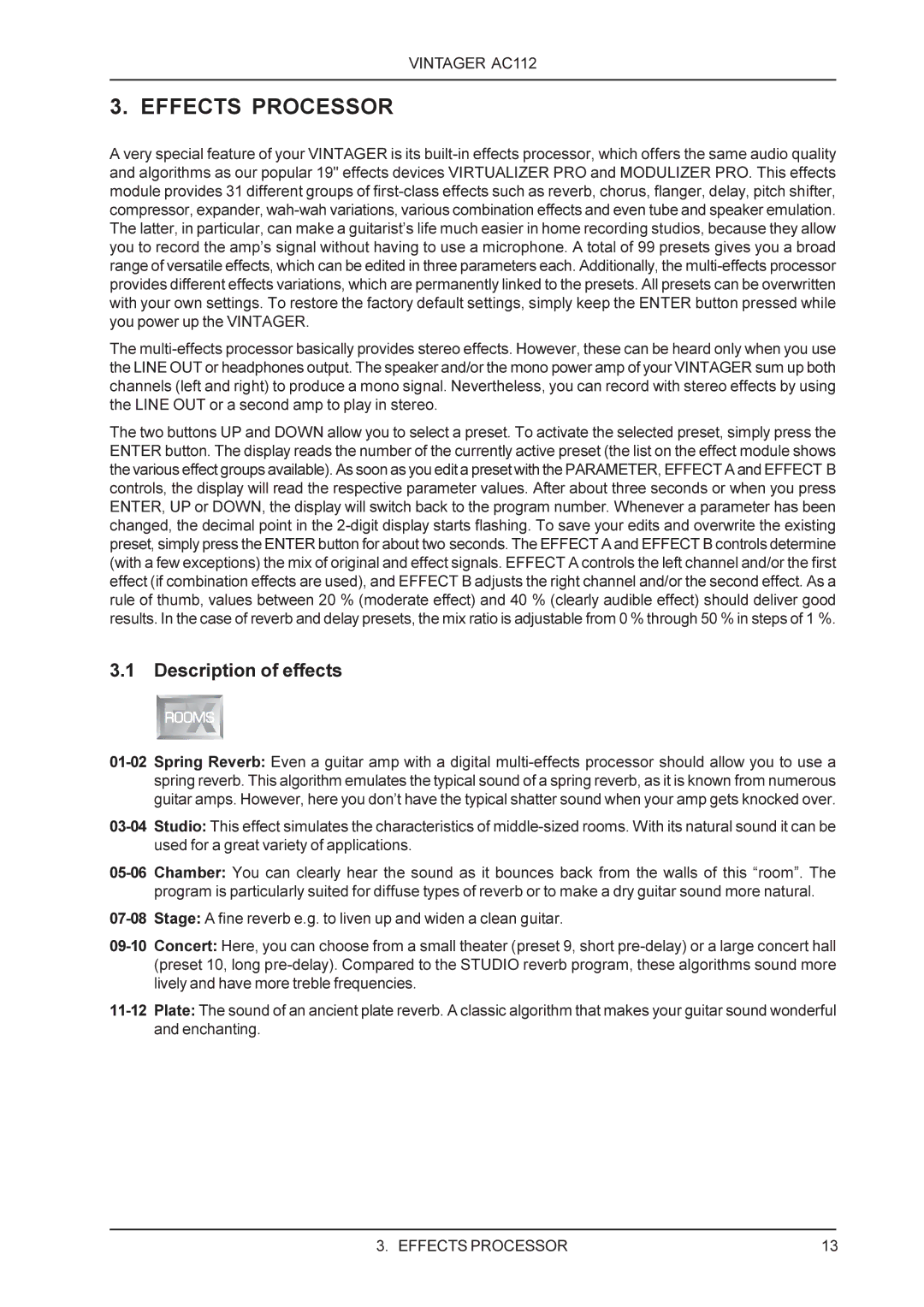VINTAGER AC112
3. EFFECTS PROCESSOR
A very special feature of your VINTAGER is its built-in effects processor, which offers the same audio quality and algorithms as our popular 19" effects devices VIRTUALIZER PRO and MODULIZER PRO. This effects module provides 31 different groups of first-class effects such as reverb, chorus, flanger, delay, pitch shifter, compressor, expander, wah-wah variations, various combination effects and even tube and speaker emulation. The latter, in particular, can make a guitarist’s life much easier in home recording studios, because they allow you to record the amp’s signal without having to use a microphone. A total of 99 presets gives you a broad range of versatile effects, which can be edited in three parameters each. Additionally, the multi-effects processor provides different effects variations, which are permanently linked to the presets. All presets can be overwritten with your own settings. To restore the factory default settings, simply keep the ENTER button pressed while you power up the VINTAGER.
The multi-effects processor basically provides stereo effects. However, these can be heard only when you use the LINE OUT or headphones output. The speaker and/or the mono power amp of your VINTAGER sum up both channels (left and right) to produce a mono signal. Nevertheless, you can record with stereo effects by using the LINE OUT or a second amp to play in stereo.
The two buttons UP and DOWN allow you to select a preset. To activate the selected preset, simply press the ENTER button. The display reads the number of the currently active preset (the list on the effect module shows the various effect groups available). As soon as you edit a preset with the PARAMETER, EFFECT A and EFFECT B controls, the display will read the respective parameter values. After about three seconds or when you press ENTER, UP or DOWN, the display will switch back to the program number. Whenever a parameter has been changed, the decimal point in the 2-digit display starts flashing. To save your edits and overwrite the existing preset, simply press the ENTER button for about two seconds. The EFFECT A and EFFECT B controls determine (with a few exceptions) the mix of original and effect signals. EFFECT A controls the left channel and/or the first effect (if combination effects are used), and EFFECT B adjusts the right channel and/or the second effect. As a rule of thumb, values between 20 % (moderate effect) and 40 % (clearly audible effect) should deliver good results. In the case of reverb and delay presets, the mix ratio is adjustable from 0 % through 50 % in steps of 1 %.
3.1Description of effects
01-02 Spring Reverb: Even a guitar amp with a digital multi-effects processor should allow you to use a spring reverb. This algorithm emulates the typical sound of a spring reverb, as it is known from numerous guitar amps. However, here you don’t have the typical shatter sound when your amp gets knocked over.
03-04 Studio: This effect simulates the characteristics of middle-sized rooms. With its natural sound it can be used for a great variety of applications.
05-06 Chamber: You can clearly hear the sound as it bounces back from the walls of this “room”. The program is particularly suited for diffuse types of reverb or to make a dry guitar sound more natural.
07-08 Stage: A fine reverb e.g. to liven up and widen a clean guitar.
09-10 Concert: Here, you can choose from a small theater (preset 9, short pre-delay) or a large concert hall (preset 10, long pre-delay). Compared to the STUDIO reverb program, these algorithms sound more lively and have more treble frequencies.
11-12 Plate: The sound of an ancient plate reverb. A classic algorithm that makes your guitar sound wonderful and enchanting.

